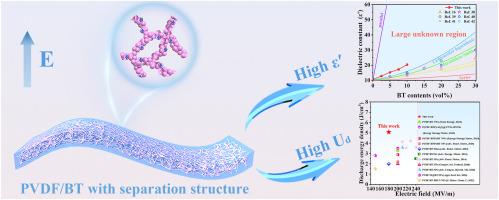Polyvinylidene fluoride/barium titanate composites with separation structure for improved energy storage density at a low field strength
IF 7.9
2区 工程技术
Q1 CHEMISTRY, PHYSICAL
引用次数: 0
Abstract
Polymer-based dielectric composites exhibit substantial potential for utilization in electrostatic energy storage. Through structural design, controlling the spatial distribution of functional fillers within a polymer matrix can effectively enhance the dielectric constant (ε′) and polarization of composites. In this study, the innovative application of a 3D separation structure, prepared through water vapor induced phase separation combined with hot-pressing technique, achieves a significant enhancement of polarization performance at relatively low electric fields in polyvinylidene fluoride/barium titanate (PVDF/BT) dielectric composites. The continuous distribution of BT in PVDF matrix effectively enhances the local electric field and helps to achieve consistent polarization direction and remarkable dipole moment enhancement. Consequently, the ε′, maximum electrical displacement (Dmax), and discharge energy density (Ud) of PVDF/BT are effectively enhanced. The addition of 10 vol% BT results in PVDF/BT composites exhibiting a ε′ exceeding 20 (103 Hz) and a Dmax of 9 μC/cm2 (180 MV/m). The Ud of PVDF/BT with 10 vol% BT added is 5.08 J/cm3 (at 180 MV/m), representing a 52.1 % growth in comparison to pure PVDF (3.34 J/cm3, 180 MV/m), and exceeding 2.5 times that of biaxially oriented polypropylene (2 J/cm3, >600 MV/m).

具有分离结构的聚偏氟乙烯/钛酸钡复合材料在低场强下提高储能密度
聚合物基介电复合材料在静电储能方面具有巨大的应用潜力。通过结构设计,控制功能填料在聚合物基体中的空间分布,可以有效提高复合材料的介电常数ε′和极化性能。在本研究中,通过水蒸气诱导相分离结合热压技术制备的三维分离结构的创新应用,实现了聚偏氟乙烯/钛酸钡(PVDF/BT)介电复合材料在相对低电场下的极化性能的显著增强。BT在PVDF矩阵中的连续分布有效地增强了局域电场,有助于实现极化方向的一致和显著的偶极矩增强。从而有效地提高了PVDF/BT材料的ε′、最大电位移(Dmax)和放电能量密度(Ud)。添加10 vol% BT的PVDF/BT复合材料ε′大于20 (103 Hz), Dmax为9 μC/cm2 (180 MV/m)。添加10 vol% BT的PVDF/BT的Ud为5.08 J/cm3 (180 MV/m),比纯PVDF (3.34 J/cm3, 180 MV/m)增加52.1%,超过双轴取向聚丙烯(2 J/cm3, 600 MV/m)的2.5倍。
本文章由计算机程序翻译,如有差异,请以英文原文为准。
求助全文
约1分钟内获得全文
求助全文
来源期刊

Journal of Power Sources
工程技术-电化学
CiteScore
16.40
自引率
6.50%
发文量
1249
审稿时长
36 days
期刊介绍:
The Journal of Power Sources is a publication catering to researchers and technologists interested in various aspects of the science, technology, and applications of electrochemical power sources. It covers original research and reviews on primary and secondary batteries, fuel cells, supercapacitors, and photo-electrochemical cells.
Topics considered include the research, development and applications of nanomaterials and novel componentry for these devices. Examples of applications of these electrochemical power sources include:
• Portable electronics
• Electric and Hybrid Electric Vehicles
• Uninterruptible Power Supply (UPS) systems
• Storage of renewable energy
• Satellites and deep space probes
• Boats and ships, drones and aircrafts
• Wearable energy storage systems
 求助内容:
求助内容: 应助结果提醒方式:
应助结果提醒方式:


